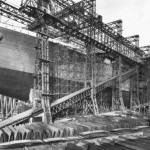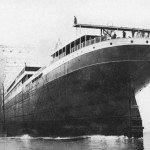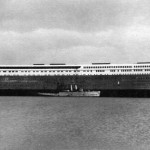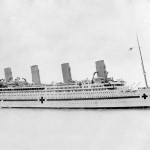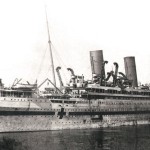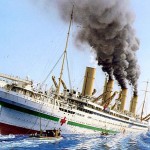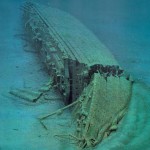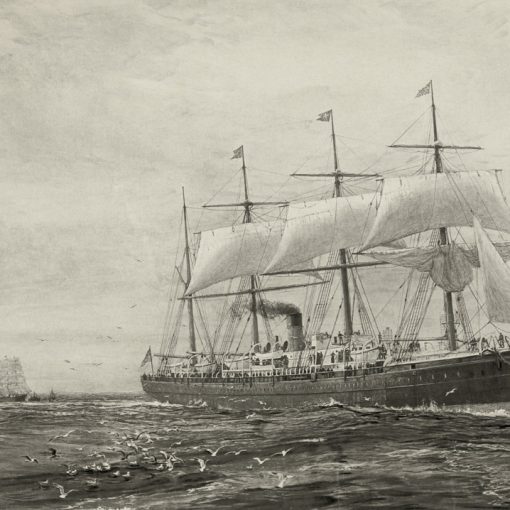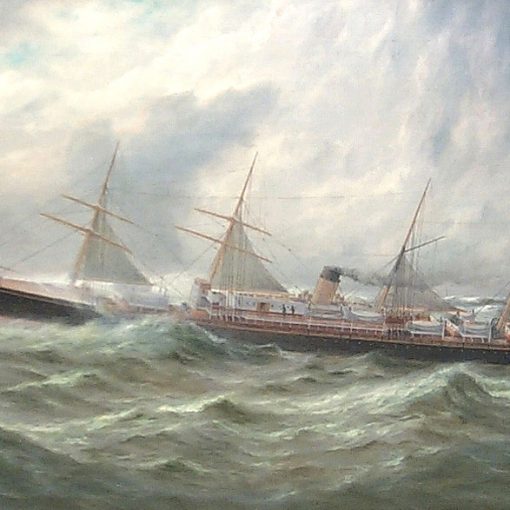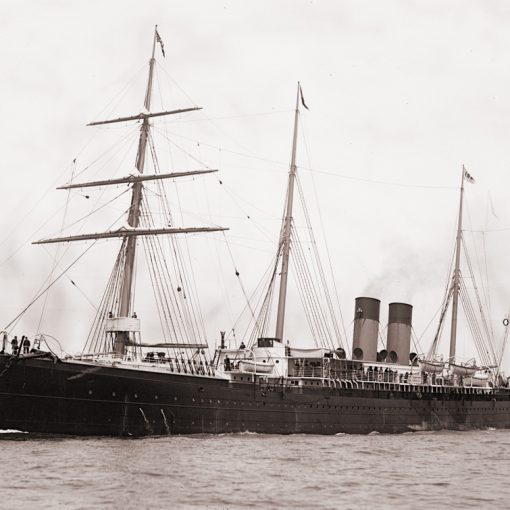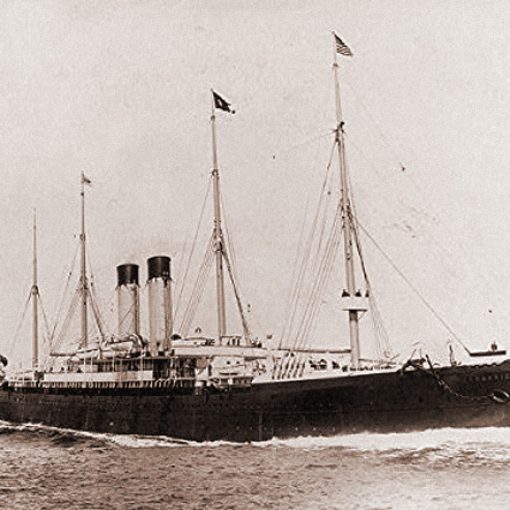1915 – 1916
By putting the Olympic and Titanic into service, the White Star Line once again had the honour of operating the largest liners in the world. The Cunard Line’s Mauretania, who previously had held this prestigious title, had in size been totally left behind when the Olympic was launched on October 20th, 1910. The Mauretania, launched in 1906, was 31,938 gross tons large and the Olympic was almost fifty percent larger with her 45,324 tons. Eventually, when the Titanic joined her older sister in the White Star fleet, it might seem as if it would take some time to surpass them.
Not so. As soon as the first keel plates on the Olympic had been laid in December 1908, other shipping lines became aware of the threatening situation and started to draw up plans of their own. The Cunard Line decided to expand their already so successful duo into a trio by commissioning the Aquitania. Her keel was laid only a few days after the launch of the Titanic. Intended to be equal to the Olympic-class in both size and luxury, she was also built to be faster, with a service speed of 23 knots. Of course, this made her a serious future competitor, and this threat to the White Star Line was not to be the only one. Germany, that had risen to be one of the world’s top maritime nations by the end of the 19th century but had eventually been surpassed by the British Lusitania and Mauretania, also wanted a piece of the action. Germany’s HAPAG had already began constructing the first ship of their own future trio; the Imperator,Vaterland and Bismarck. All of these three ships had a projected gross tonnage of over 50,000 tons, and it was clear that when completed, the Imperator would undoubtedly surpass the Olympic and Titanic.
But this was no surprise to the White Star Line. Being aware of the stiff competition, they had foreseen this situation and taken the necessary steps to deal with it. On that now-famous dinner party at the Belgravia residence of Lord Pirrie, where it is said that the Olympic-class liners were first conceived, it was decided by Bruce Ismay and Lord Pirrie that when completed, the Olympic and Titanic would later be joined by a third sister, originally intended to bare the name Gigantic.
The two first sisters were built side by side in the shipyards of Harland & Wolff in Belfast. On the location once occupied by three gantries the yard had constructed two mammoth gantries, all to be able of handling ships with these so far unprecedented dimensions. When the Olympic was launched, it might seem as if it would have been best to commence construction of the third sister as soon as possible. But this was not done, mainly because of two reasons. On one hand, the yard had orders from other shipping lines, and could not leave the gantry previously occupied by the Olympic unused. On the other hand, the White Star Line wanted to be absolutely sure of the performance of their new vessels before signing a contract for a third. But any doubts that may have been was put aside when the Olympic made her maiden voyage in June 1911. According to Bruce Ismay, chairman of the White Star Line and on board the Olympic on her maiden voyage, she was fantastic and as soon as he arrived in New York he telegraphed the main office, writing ‘The Olympic is a marvel, and has given unbounded satisfactory’. The contract for the third sister was thus signed and on November 23rd, 1911, the place needed for construction was at last made vacant with the launch of the Arlanza. Shortly afterwards, work began on hull number 433, on the same slipway that had once housed the Olympic.
When the Olympic was put into service, some faults in her construction soon became evident. The forward part of the A-deck promenade space for example proved to be subjected to greater amounts of spray than first thought, and the B-deck promenade seemed to be unnecessary, since passengers preferred the decks above. These problems were deleted on the Titanic, by enclosing the forward A-deck promenade and by extending the first class cabins on B-deck all the way out, thus erasing the obsolete promenade area. It was such changes that ultimately made the Titanic somewhat bigger and more luxurious than her sister. And now that construction of the third and last ship of the Olympic-class was underway, she was meant to incorporate the very best of her two predecessors. On the blueprints, the most significant changes were found on the ship’s stern. The aft Shelter Deck was now enclosed, creating a covered exterior deck-area also for the third class-passengers. But the most extensive changes to the new ship’s design were yet to come.
On April 14th 1912, the Titanic struck an iceberg on her maiden voyage and went down, taking with her 1,500 souls in the depths. The world was shocked. The Titanic, launched as the greatest work of man and claimed to be unsinkable, had gone down in just over two and a half hours. The two enquiries held shortly after the tragedy very soon found that the safety rules for ships were hopelessly outdated. Above all, the most appalling fact was that the Titanic (and all other great ships of that time for that matter) had been allowed to sail with a lifeboat capacity of just a third of her total passenger capacity. New rules were immediately made, and shipping lines across the globe had much work to do to meet these new requirements.
The company with the hardest work ahead of them was the White Star Line. It was they who had let the Titanic sail with an inadequate number of lifeboats, and their reputation was all other than spotless in the general opinion’s eyes. The Olympic was quickly called into Belfast for major alterations in her design. Her bulkheads were raised and an inner skin, running the full length of the vessel, was installed, thus making her capable of surviving the damage that had sunk the Titanic. In addition, extra lifeboats were installed, now along the entire length of the Boat Deck. After five months out of service and £ 250,000 spent, the Olympic returned to traffic the North Atlantic on April 2nd, 1913.
On the third ship, construction was immediately halted after the Titanic-disaster, and the intended name Gigantic was replaced with Britannic. Although the White Star Line denied that the ship originally would have been named Gigantic, statements in the press before the Titanic-disaster claims otherwise. It seems likely that the third ship would bare a name similar to her sisters, but to call the ship Gigantic would have been a demonstration of the same attitude that had led to the Titanic’s name. Therefore, the ship was named Britannic.
Awaiting the results of the inquiries, engineers started to make alterations to the design. As construction was still at an early stage, this meant that it would be easier to incorporate the new safety requirements on the third vessel. Ultimately, these features would give her a design distinct from her two older sisters. In the electric engine room, an extra bulkhead was added, thus dividing the ship into seventeen watertight compartments instead of sixteen. Five of the ship’s bulkhead now went as far up as the Bridge Deck, about 40 feet above the waterline. This design would in theory make her the most ‘unsinkable’ ship so far, being able to survive with her six forwardmost compartments flooded. But visually, the most striking new feature was the lifeboat arrangements. Instead of adding boats along the whole Boat Deck, Harland & Wolff decided to install another type of davits, much larger than the Welin-davits on the Titanic and Olympic. These would allow the Britannic to carry 48 lifeboats, of which two would be fitted with their own engines and wireless apparatus. Lifeboats were also installed on the stern of the ship above each other, a solution made possible by the large davits. As a further safety precaution, a pneumatic tube was installed between the wireless room and the bridge, thereby allowing the wireless operators to relay messages to the bridge without leaving their post.
Work on the Britannic continued throughout 1912, but more slowly than expected. The launch was delayed several times and it was not until February 26th, 1914, that the Britannic would be put into her right element. It was a cold morning, but in spite of this, several noted persons of the company’s board had gathered to witness the birth of their latest liner. In accordance with White Star tradition, there was no ceremony, and no champagne bottle smashed against the bow of the ship. At a quarter past 11 a.m., the hydraulic launching triggers were released, and the massive hull started its journey to the water. All went well, and five tugs immediately started to tow the empty ship to the fitting out wharf, where she would be transformed into Britain’s largest and most luxurious ship so far.
For the following six months, the Britannic slowly began taking shape as the luxurious vessel she was supposed to be. But work did not proceed at a very high pace, as Harland & Wolff were having financial troubles. And in August 1914, something happened that would change the fate of the Britannic’s life. Great Britain, France and Russia declared war on Germany and Austria-Hungary, thus making the First World War a fact.
The war quickly had a profound impact on the shipbuilding industry. The shipyards with admiralty contracts were given the highest priority, and also the larger part of available raw materials. No admiralty orders were placed with Harland & Wolff, making them able to continue their civil contracts, but at a considerably slower pace. By September, the Britannic was placed in the Thompson graving dock to have her propellers fitted. In the meantime, the war had its effect on the shipping lines too. The port of Southampton was requisitioned by the military for use as a base to ship troops to France from. White Star Line was therefore forced to move their main terminus to Liverpool. In addition, many of the company’s ships were soon requisitioned by the Admiralty. The Oceanic, Celtic, Cedric and Teutonic were all under military command by the end of 1914 as armed merchant cruisers, and the Megantic and Laurentic were serving their nation as troopships. The larger Britannic and Olympic were both laid up until the need was big enough to justify the use of such important vessels. On November 3rd, the Olympic arrived in Belfast, where she would spend the next ten months together with her younger sibling.
The year 1915 came, and the pressure upon the merchant fleets was hard. The larger vessels had so far laid unused because of the great costs involved in operating such a ship, but the situation had by now worsened and the loss of several vessels showed that it seemed only a matter of time before the two titans would come into military use. Eventually, on September 1st, 1915, the Olympic was requisitioned as a troopship, but the Britannic still lay unfinished in Belfast.
By now, the war that ‘would be over by Christmas 1914’ had almost gone out of control. In the Mediterranean, the amount of casualties was getting bigger by the day, mainly because of the Dardanelles campaign. The Cunarders Aquitania and Mauretania were already serving as hospital ships, but more were needed. On November 13th 1915, the Britannic was therefore requisitioned by the Admiralty as a hospital ship. The work of transforming the half-completed Atlantic liner was soon under way at a high pace. The staterooms on the upper decks were turned into wards, as patients would need to be placed as close to the Boat Deck as possible. The first class dining saloon and reception room were both turned into operating theatres and main wards because of their central locations. Surgeons, doctors and nurses would inhabit the staterooms on B-deck, so that they would be close to the patients at all time. As the ship at last was ready, she had place for a total of 3,309 patients, surpassed only by the Aquitania who could carry 4,182.
Externally, not all went as planned. There was no time to fit the ship with a complete set of the new type of davits. To fill in the missing gaps, smaller Welin-type davits were installed instead. These could not manage quite as big lifeboats and therefore a greater number of smaller ones were installed. When a completed hospital ship, the Britannic would carry 58 lifeboats of different kinds. The ship was also painted in the internationally recognised colours of a hospital ship; white with a green band running along the hull interrupted in three places on each side by red crosses. The funnels were painted in a colour similar to the White Star-buff, but there was no black top. These colours would make the ship safe from any attacks, in accordance with the Geneva Convention. On December 14th, 1915, Captain Charles Bartlett was given command of His Majesty’s Hospital Ship Britannic, number G618. By Christmas, she would be ready for her maiden voyage.
On December 23rd, the Britannic left on her maiden voyage, bound for Mudros, on the Greek island of Lemnos. Five days later, she arrived at Naples, her only port of call before Mudros, to take on coal and water. Arriving at Mudros on New Year’s Eve, she immediately began to take on casualties, a procedure that would take four days. On January 9th, the Britannic arrived in Southampton and started to offload her patients. Two more voyages were made, but by the spring of 1916, the situation in the Mediterranean was calming down, and the larger hospital ships were being laid up until their services was needed again. The Mauretania went in March, and in April she was followed by the Aquitania. The Britannic was laid up in Southampton on April 12th, and lay unused in the Solent for the following five weeks. Then, due to financial troubles experienced by the War Office, it was decided that she would be returned to commercial service with the White Star Line. On May 18th, she arrived in Belfast and was released from Government service on June 6th. But by September 1916, the Allied offensive in the Mediterranean once again increased, and soon it was evident that the great liners once again would be called into hospital service.
On September 4th, Captain Bartlett was once again given command of the H.M.H.S. Britannic, and on the 24th she was on her way to the Mediterranean for the fourth time. One more voyage was completed between October 20th and November 6th, but the situation in the Mediterranean required her to go back almost immediately. On November 12th, she left on her sixth voyage, yet again bound for Mudros.
Little did the crew of the Britannic know, that on October 28th, the very same day that she last arrived at Mudros, the German U-boat U73 under the command of Kapitänleutnant Gustav Siess, had been busy laying mines in the Kea Channel between the island of Kea and the Greek mainland. On the morning of November 21st, the Britannic was approaching these waters with a speed of 20 knots, scheduled to arrive at Mudros later that day. By 8 a.m., while breakfast was being served for the medical staff, Captain Bartlett ordered a slight change of course in order to bring the ship into the channel of Kea.
Suddenly, at 8.12 a.m., the ship was shattered by an explosion on the starboard bow. Major Harold Priestly immediately seized command in the dining room and instructed the nurses to continue their breakfast, as the captain had not ordered the ship evacuated. Not many thought that the situation was very serious, and some even made jokes about being sorry for the boat they had ran into. In the meantime, Captain Bartlett was trying to determine the best cause of action to save his ship, since she was starting to list towards the bow and to the starboard. He ordered the watertight doors closed and distress signals sent. The blast had destroyed the bulkhead between hold no. 1 and the forepeak, and in addition the fireman’s tunnel had also been damaged, thus allowing water to enter the boiler room. With the four forward compartments open to the sea, the Britannic should still be safe. But to make matters worse, the watertight door between boiler rooms 5 and 6 had failed to close, making it possible for the in-rushing water to continue further aft. The list to starboard also contributed to worsen the situation. Many of the portholes had been opened earlier that morning, in order to ventilate the lower decks. Now, they would unfortunately present another way for the water to penetrate the ship’s hull.
With these facts in mind, Captain Bartlett soon made the decision to try and beach the ship on the beaches of the nearby island of Kea. He quickly abandoned this effort, since the forward motion meant that water would rush into the ship at a higher pace. Ordering the engines stopped, the evacuation of the people on board was given top priority. And help was on the way. The distress calls had been picked up by several ships. The British destroyer Scourge, the auxiliary cruiser Heroic and the destroyer Foxhound were some of those ships that were now coming to the rescue.
On board the Britannic, the evacuation continued. There were few examples of panic, but one was shown when a group of firemen took one of the Poop Deck lifeboats without permission. Captain Harry Dyke, who was lowering boats from the aft starboard Boat Deck quickly remedied this loss of a boat by ordering the firemen to pick up a number of men who had already jumped from the ship’s side. Apart from this exception, no boat had yet been put into the water. A few was lowered, but as the Britannic was still going forward, the crew was reluctant to release the boats until the ship had come to a halt. But despite this precaution there was an accident that would greatly increase the number of lost lives on this day. Two boats from the port side were lowered without authority, and soon found themselves caught in the suction created by the still turning propellers, which were now breaking the surface. Unable to stop the inevitable, the two boats were pulled in and torn apart by the enormous screws. By the time the propellers were completely stopped, more than 70 people had either died or received serious injuries.
As the list to starboard became greater, the more difficult it was to lower boats on the port side. As the water rushed in over the bow, Captain Bartlett sounded one blast on the ship’s whistle, thereby signalling the order to abandon ship. This sound must have been a welcome one for the engineers down in the engine room, who now could escape through the last available way; up the fourth funnel.
At 9.07 a.m., the ship finally rolled over on her side and sank, less than an hour after the initial explosion. Captain Bartlett, who now found himself in the water, swam to a lifeboat, and by 10 a.m., the Scourge arrived at the scene and started picking up survivors.
The aftermath of the sinking was not very lively. The Britannic was just another ship who had been sunk by the Germans, and there were barely any investigations at all. Still, there were a great number of questions that remained unanswered. First and foremost: How could the Britannic, which was much safer than the Titanic, sink in just a little less than an hour, when it had taken the Titanic two and a half? Debate about possible hidden weapons in her cargo took place, but this was of course denied by the Admiralty. And was it a mine or a torpedo that had caused the fatal explosion? The first person to really seek out answers to these questions was Jacques Cousteau, in co-operation with the Titanic Historical Society. On December 3rd, 1975, Cousteau located the wreck of the Britannic, but on a different location than the one given by the British Admiralty. The following year Cousteau returned to the site for a closer look at the wreck. But with the rather crude diving equipment of that time, Cousteau was not able of getting a clear picture of the Britannic.
It was not until the summer of 1995 that the Britannic was visited again, this time by Dr. Robert D. Ballard. Bringing with him state-of-the-art diving technology, he was able to thoroughly examine the wreck. The Britannic lies at a depth of 390 feet, on her starboard side. She is remarkable well preserved and the only massive damage is that to the bow. Upon impact with the bottom, the bow was bent upwards and almost torn free from the remaining part of the ship. The funnels that fell off during the sinking can still be found around the wreck, although collapsed.
Being amazed of how well preserved the Britannic is, Dr. Ballard uttered his hope to protect the wreck and possibly even turn it into the world’s first underwater museum. Although no such plans have come to fruition since his expedition, it would indeed be fitting if this honour was given to the greatest sunken liner on the ocean floor.
Specifications
- 903 feet (275.8 m) long
- 94 feet (28.7 m) wide
- 48,158 gross tons
- Reciprocating engines developing 32,000 HP for the two wing-propellers and a steam turbine developing 18,000 HP for the centre propeller
- 21 knot service speed

